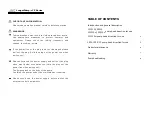
Eaton’s Crouse-Hinds Business
Cooper Crouse-Hinds Pte Ltd
No. 2 Serangoon North Ave 5 #06-01
Singapore 554911
tel: + 65 6645 9888
fax: +65 6297 4819
Page 50
Example:
Current signal amplitude is 900 mV, current low limit is 500 mV, current high
limit is 1100 mV. When executing the wizard, the user selects 30 %.
Calculated new low limit: 900 mV 30 % = 630 mV; as this is higher than the
current low limit, it will be accepted as the new low limit.
Calculated new high limit: 900 mV + 30 % = 1170 mV; as this is not lower
than the current high limit, it will not be accepted as the new high limit, and the
high limit remains at 1100 mV.
The final limit setting for this example will be: low: 630 mV, high: 1100 mV.
o
Step 4: Calculation of noise limits
The noise high-limits will be set according to the following table. The high-
high-limits will remain unchanged.
Alarm wizard criteria High-limit (PreAlert)
Avg Fieldbus Frequency Noise (mV) if actual <25
50
Avg High Frequency Noise (mV)
if actual <50
100
Avg Low Frequency Noise (mV)
if actual <50
100
Peak Fieldbus Frequency Noise(mV) if actual <150
300
Peak High Frequency Noise (mV)
if actual <300
600
Peak Low Frequency Noise (mV)
if actual <300
600
If the actual values > respective limit listed in the table (e.g. actual Avg
Fieldbus Frequency Noise > 25 mV), the high-limit (PreAlert) will remain
unchanged.
Note that the limit values have to be in rising sequence at all times:
high-limit
≤
high-high-limit
In case the calculated high limit is higher than the high-high-limit stored in the
F809F, the wizard will reject the calculated value and keep the old high limit
value without notification to the user.















































